Within your wider content marketing strategy, knowing how to properly structure your content is crucial. Your site visitors need to be able to access and navigate it with ease, and search engines need to be able to connect the dots — especially when you’re targeting broader high-value keywords.
The solution to this is to implement content hubs across your website. They allow you to build and expand your expertise on a particular topic, all the while ensuring that this content group is centralized and easily found, both by humans and search engines.
In this article, we will attempt to explain what exactly a content hub is, why it’s beneficial for your business to have one, and — of course — how to build your own in 2021.
What Is a Content Hub in SEO?
In simple terms, a content hub is a destination on your website containing content around a certain topic. It is a focal point for a particular topic or subject.
In the center of a content hub is the pillar content. Generally, this content is intended to give a high-level overview of the subject in question and can be either a long-read or simply a centralized hub page (depending on the type of site you run and the given topic).
This pillar content is then supported by other pieces that tend to go more in-depth on the different elements of that same topic. This is cluster content and could take on any media format.
So what does this look like in reality? Well, imagine that you run an online business selling car parts, and you want to focus specifically on tires. Your first step could be to create an “ultimate guide” to tires, including how they work, the different kinds of tires, and how to look after them. Next, you'd explore each of those themes and subthemes in detail.
We’ll give you a step-by-step explanation of how to do this further down in the article.
Why Are Content Hubs Important?
If you have a wealth of high-quality, detailed content on a particular topic, it helps make Google recognize you as a credible authority on that topic. Well-organized resources that cover different elements of a broad topic are also more conducive to getting backlinks which, again, can boost your domain authority.
As a result of this cycle, you will then be more likely to rank higher for your target topics and keywords, allowing you to have well-positioned content at multiple stages of the content funnel.
That said, it’s not all about endearing yourself to search engines. At the end of the day, what really matters is our audience and the experiences we create for users landing on our website. The underlying structure of content hubs enables you to map out your content more effectively, and have a clear, defined outlay — which your customers will likely appreciate, too.
How To Create a Winning Content Hub
So now that we know what content hubs are and why they should matter, it’s time to get our hands dirty. Here are the seven core steps you need to follow to build a content hub from scratch.
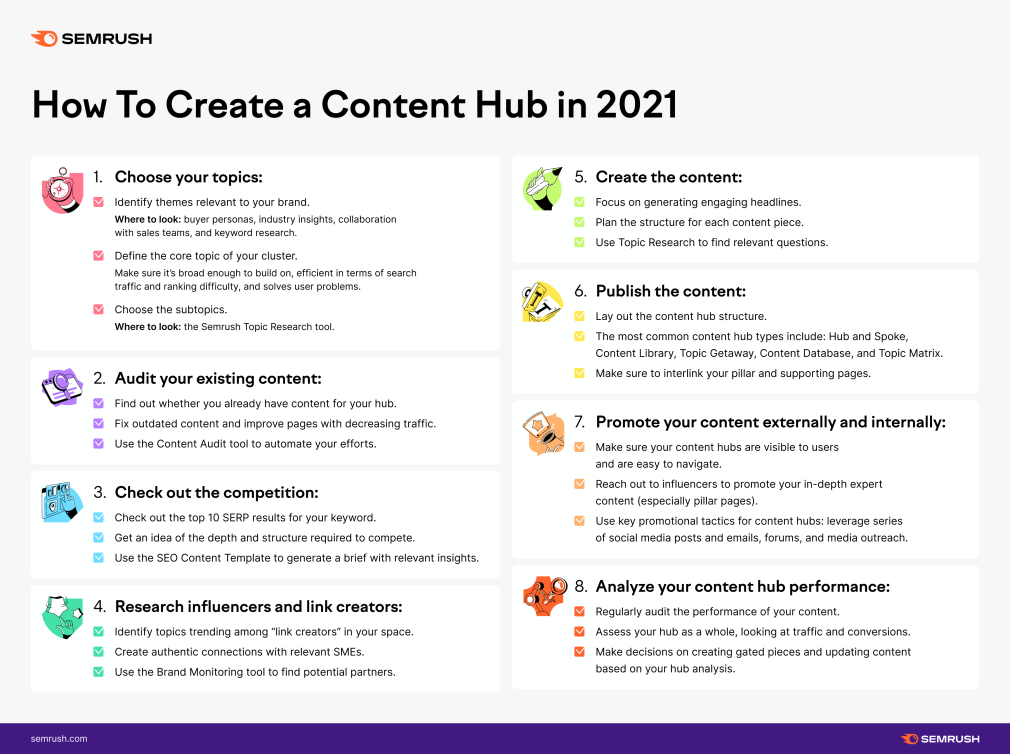
Before you start: decide where to host your content hub
Think about whether your content hub will be part of your business website or become a separate entity. It's rather common to create multiple thematical content hubs on your core domain, which helps with reaching SEO and engagement goals.
However, some companies choose to create standalone hubs. For example, Walton's publish their content and engage their community through Meatgistics, which serves as a community site, a blog, a knowledge base, and everything in between. Here are the benefits of creating your content hub on a separate domain:
Opting for this format can help you create a space where your customers will interact with each other and your brand on a new level. It can also benefit larger companies, where making changes on the core website can take weeks, if not months. Finally, such standalone hubs are great for running experiments and testing new audiences.There are also substantial benefits of building content hubs on your main domain:
Building content hubs on your website will require fewer resources and commitment. It's usually easier to manage such hubs and to implement end-to-end analytics. Besides, such hubs will potentially bring more direct SEO benefits.The final decision will depend on your specific needs and situation. Now, let's see how to create a high-performing content hub.
Step 1. Identify the Themes You Want to Cover
The very first thing that you’ll need to do is conduct a brainstorming session and identify the key themes you’d like to cover with your content. To assist you in this process, you can refer to:
Your buyer persona. When drawing on your ideal buyer persona, think about the level of knowledge they are likely to have. If you sell digital cameras, for instance, is your buyer persona an entry-level photographer who has little to no idea of which camera they should buy? Or are they an experienced professional that is looking for a very specific technical solution? Straight away, this can give you an idea of the kind of problems your target audience wants help with. Your sales team. If applicable, consult your sales teams to see what customers are telling them, and try to find out the most common difficulties those customers are reporting. Ask your sales reps for their own input, too. What types of content would make their job easier, and create a more effective sales funnel? The answers to these questions can often throw up some great topic ideas that fill a very valuable gap. Another alternative is to analyze customer reviews, and customer support questions and monitor social mentions to spot potential themes your customers are bringing up. Competitive content analysis is also essential when getting an initial idea of which themes and topics resonate with your audience.Choosing the Main Topic
With this in mind, Semrush’s Topic Research tool is an ideal place to start.
To illustrate how let’s say that you run a small business selling your own brand of coffee beans.
Using the seed keyword ‘coffee beans’, you consult Topic Research, which suggests a range of potential topics:
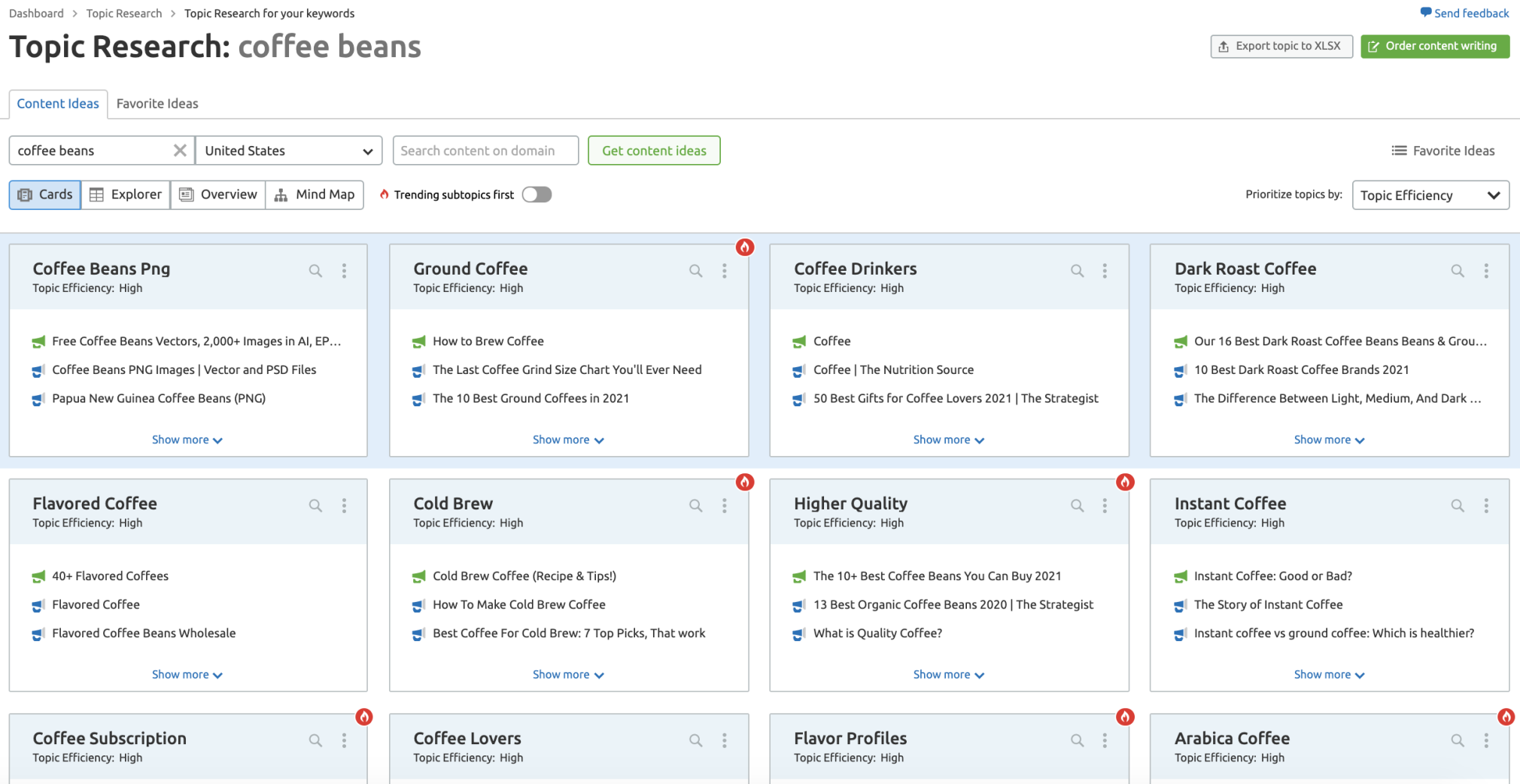
Using just this one seed keyword, you immediately have a list of potential pillar topics. But how do you know which topics are worth pursuing, and which are unlikely to yield much success?
Generally speaking, your chosen pillar topic needs to satisfy three key pieces of criteria. It should:
Possess informational intent and purpose. If we look at the ‘coffee beans’ example above, we can see that nearly every suggestion is based around searchers looking for information. For instance, users want to know how to make a cold brew coffee; what single-origin coffee is; which is healthier — instant or ground? You want to ignore product listings or irrelevant locally targeted content here, and focus only on topics that will solve a user’s problem or answer a specific question. Have search potential. It might sound obvious, but it doesn’t make sense to pursue topics that don’t attract search engine traffic. In Topic Research, you can filter the results based on volume (the topic’s popularity), ranking difficulty, and topic efficiency (especially handy if you have a lower-authority website), so check to see what levels of traffic and exposure you could potentially be looking at. Be broad enough to support your subtopics. This is arguably the trickiest criteria to meet, as you want your topic to be broad enough to build around, but not so broad that it alienates searcher intent or is unable to compete. There is no set ideal number of subtopics that you need to create (this depends on the format of your content hub and the content on your website), but your pillar topic should be able to support them convincingly. And of course, it should also resonate with your audience and be relevant to your product offering.For instance, in our example, if we select the ‘Cold Brew’ card, we get the following list of ideas:

In this case, it would be a good idea to use ‘cold brew’ as a primary keyword for your pillar content, and then create a cluster of subtopics that explores each of the related questions in more detail.
Once you have identified a topic that ticks all three of these boxes, you can mark it down as a suitable topic for your content hub.
Choosing Subtopics
When selecting subtopics, the key point to remember is that they should be relevant to the core topic. If we go back to our car parts example, for instance, we wouldn’t include a guide on how to check your oil level in the ‘tyres’ hub (even though this is a great topic and would be suitable for a different hub, like ‘basic car maintenance’).
Instead, you should see your cluster content as an opportunity to go deeper into the subjects that your pillar content has only touched upon.
For example, let’s say that you run a blog about craft beer, and you have used Topic Research to identify your core topic as “how to make your own craft beer.”
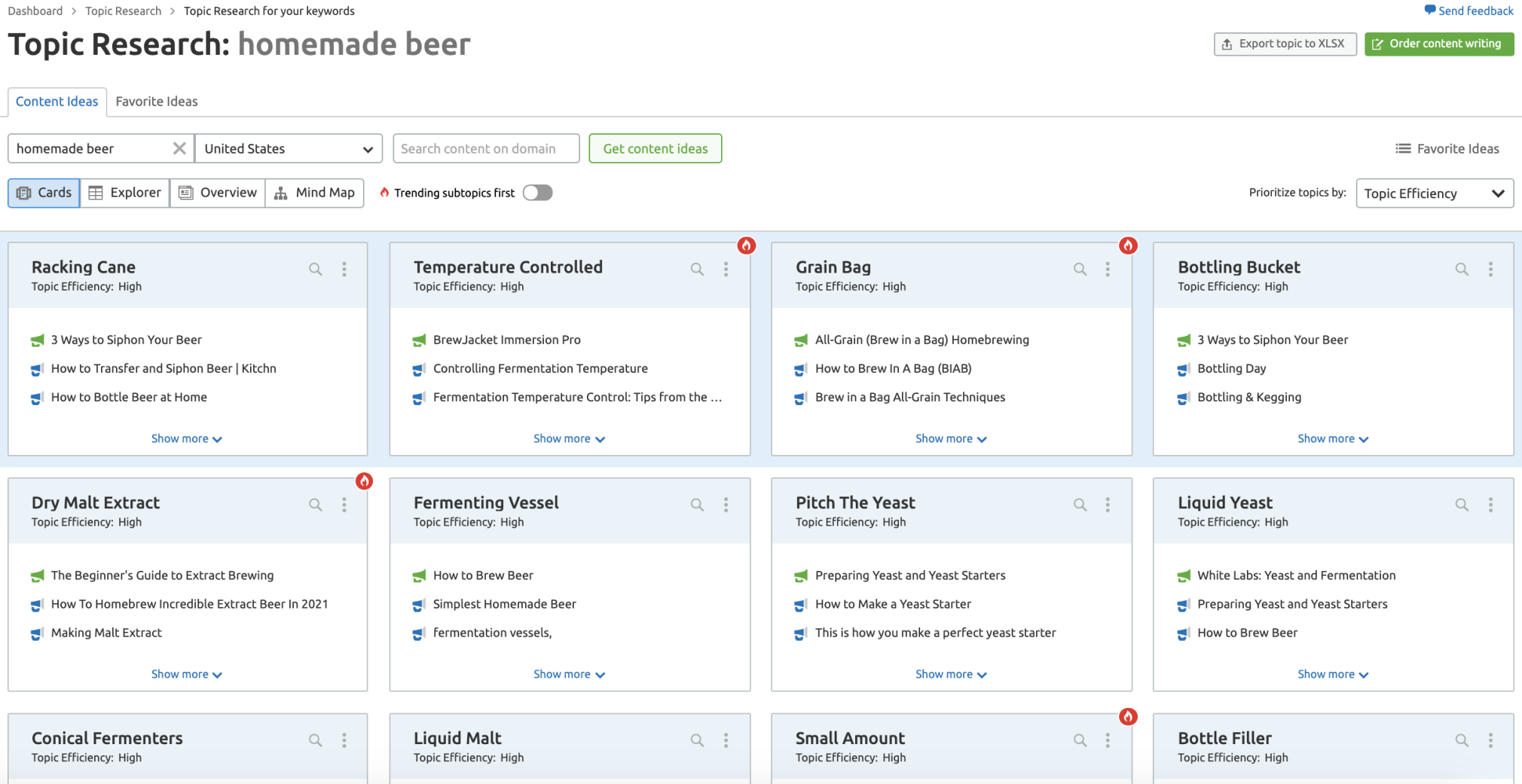
The tool suggests a wealth of supporting subtopics around this, expanding on the procedures and processes involved in brewing beer. Some of the best ones suggested by the tool include:
Empowering dry yeast with simple rehydration How to check alcohol by volume in your homemade beer How to use priming sugar to bottle homemade beer How to transfer and siphon beerThese subtopics would be perfect for supporting cluster content, and the Topic Research tool has already identified that they get sufficient traffic to be worth pursuing.
2. Audit and Update Your Existing Content
Once you’ve identified your core topic, it’s worth auditing your existing content. Maybe you’ve already covered some of your new topics, or there are certain elements of your old content that can be curated, updated, and repurposed.
For example, you may have already written a ‘how-to’ guide on a certain topic that can be tweaked and updated, or you may have touched upon it in another article that you can draw from.
A content audit is important because not just does it save you the time and resources of potentially recreating content that you already have, but it also ensures that you avoid cannibalizing your own keywords.
This can be a big task (especially if you have a large content library), so use the Content Audit tool to automate the process. This lets you see which content needs to be updated and what can be removed, saving you the time and effort of analyzing every piece of content individually.
Once you have identified the pieces that could be relevant, make any recommended changes and ensure that it is structured and targeted in a way that will be consistent with the rest of your hub content.
3. Check out the Competition
Once you have identified your topics, the next step is to get an idea of what the format, length, and structure for each content piece should look like. The best way to do this is to check out what has worked successfully for your competitors.
You can do this by simply typing your target keyword into Google, and looking at the top 10 results. How much depth do the top results go into? How up-to-date and accurate is their information? What do they cover and, importantly, what have they missed?
This last factor is especially crucial, as your content piece should aim to cover any gaps that your competitors have overlooked. Therefore, you should try to see where you can provide the kind of insight and value that others haven’t. You’re not looking to reinvent the wheel, after all, but to provide a more comprehensive and valuable piece of content than anyone else.
When it comes to writing the content (or preparing the brief for another writer), the Semrush SEO Content Template tool can help with this. It automatically analyzes these top 10 competitors’ articles based on your chosen keyword. As a result, it provides you with actionable recommendations on keywords, readability, length, backlinks and other important items for your content. In addition, it lists the top 10 competitors to make the analysis easier for your writers.
Don’t necessarily assume that, if the top results have a significant domain authority, you’ll be unable to compete, too.
Remember: one of the key benefits of a content hub is that it allows you to become an authority on a subject, so don’t be put off competing for the more difficult keywords and phrases.
4. Research Influencers and Link Creators
An important part of establishing credibility for your content is for it to be supported by experts and influencers in the subject’s field. Take our coffee beans example, for instance; you’d ideally want your content to be supported by input from professional baristas, coffee bean farmers, or coffee bloggers with spheres of influence among your target audience.
Most of the time, the purpose of this step is simply to put some weight behind your content, but it’s worth noting that in some cases, it’s actually compulsory. If you’re writing about dieting, wellness, healthcare, or anything that is tied to science, for example, then your content will most certainly need to be supported by experts in those fields.
Besides, analyzing what’s trending among thought leaders in your field can help you get a better idea of what content will resonate and generate more backlinks.
Therefore, before you begin creating the content, you should start researching and reaching out to the relevant people, and initiating relationships that you can capitalize on further down the line. You can do this by:
Following their social media pages Interacting sincerely with their posts Following and commenting on their blog posts Connecting on professional networking sites such as LinkedIn Reaching out to directly through email or website forms5. Create the Content
Once you have identified your topics, looked at how your competitors are approaching them, and made contact with the relevant subject experts, you can then move on to the crux of the process: writing the content itself.
Of course, whether you assign the content to your in-house team, or outsource it to a trusted third party, it’s important that it adheres to all the best practices of successful content.
You can use the SEO Writing Assistant to ensure that your piece is SEO-friendly, readable, and consistent in tone.
With hub content, there are a couple of extra things to keep in mind, though.
In what order should you be writing content for your content hub?
Firstly, you should write your content in the right order. The Content Marketing Institute recommends that you write your cluster pieces first, as this mitigates the risk of duplicating any key points. It also means that when you do write your pillar piece, you will already have all the links available to put into the text.
How to distribute topics between the pillar page and cluster pages?
Another key thing to remember here is that your cluster content is meant to be a deep dive of the subtopic. That means that, in your pillar content, you shouldn’t discuss the subtopic in any great detail (ideally no more than a paragraph). In this way, you can almost think of your pillar content as an extended contents section in a book, with each piece of cluster content representing the relevant chapter.
Finally, you should also pay close attention to the title and the structure.
Choosing a Title
Of course, your article’s title is crucial, both from an SEO perspective and for the intent of the searcher. It’s always a good idea to make a note of the titles that your top 10 competitors are using (see step 3), as these are the titles that are obviously ticking these two boxes the most effectively.
From a content hub perspective, though, it’s doubly important to ensure that your titles don’t clash as this will confuse both readers and search engines. For example, if you have one article entitled “10 Tips for Baking Bread” and another called “6 Things to Remember When Baking Bread”, this might be confusing, even if the target keywords are different.
Creating a Hub Structure
Again, you can look at the structures of your competitors’ articles and identify what needs to be covered, but you can also use Topic Research to cover all your bases and ensure that you haven’t missed anything.
To do this, open the card of your chosen topic (in this instance, “how to make beer”). In the ‘Questions’ section on the right, you will see a wide list of common questions that searchers for this topic often have. These can serve as the basis of your entire article and give you an excellent idea of what exactly you should cover, as this is the information that your readers are looking to obtain.
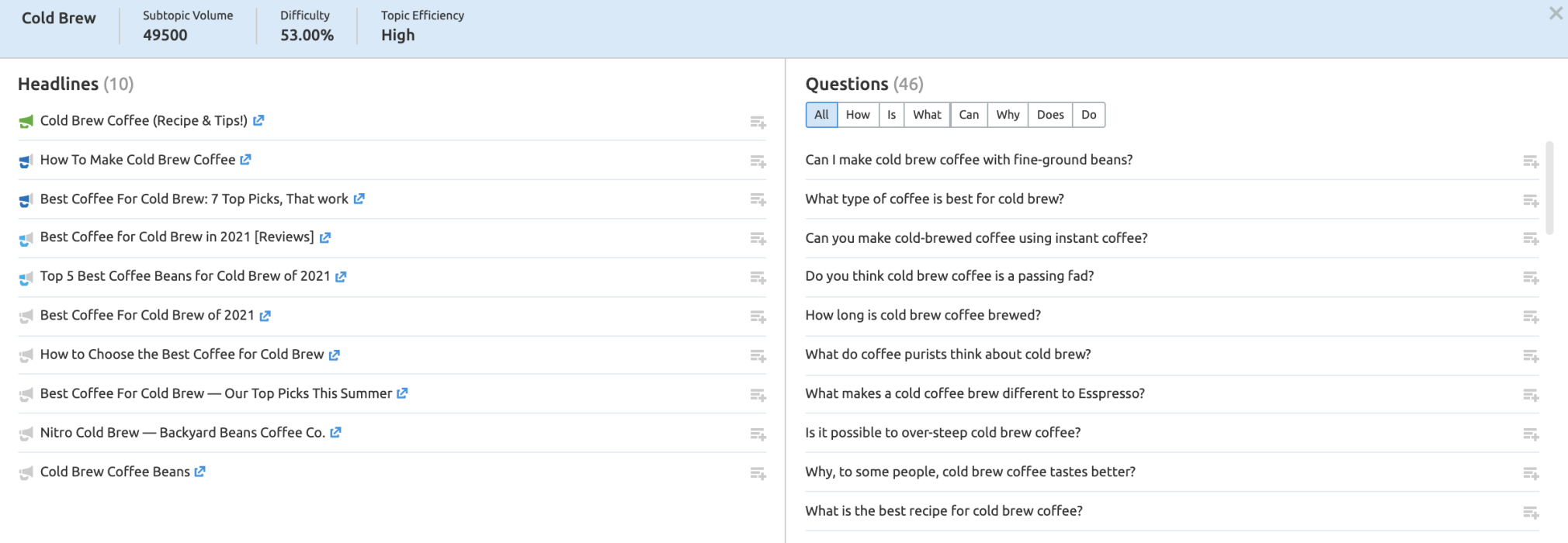
You can line this up against what your competitors have already discussed, and then cover any additional gaps that they have missed, thus adding more value and relevance to your piece.
Finally, contact the influencers and link creators that you reached out to earlier, and ask them if they can give you a quote (or contribute to your new content in some other way). They are more likely to help you at this point, because you have already made the effort to establish a relationship with them, and are not contacting them out of the blue. Once you have got some expert takes, you can then begin incorporating them into your content.
6. Publish the Content!
Once your cluster content:
has a suitable title; is able to compete in terms of depth with the other top 10 search results; is unique and genuinely valuable; and is backed up by expert insight;...you can then start hitting the publish button. In terms of how often you should hit that button, there is no right or wrong answer. However, you are obviously more likely to see traffic growth and engagement if you publish, say, five pieces of content per month, as opposed to just one.
You don’t have to wait until all your cluster pieces are live before you publish your pillar piece, either. In fact, it’s advisable to keep building more and more content around that pillar piece, and to continually update it so that it always remains the most practical, accurate, and informative solution for readers.
Once your content starts going live, there’s a couple of other things you need to consider, too.
Interlinking
Interlinking is one of the most important steps in the process as — from an SEO perspective, at least — it’s the whole point of the content hub model.
Therefore, ensure that in every piece of cluster content, you are linking back to the main pillar piece (you will have to do this post-publication for those pieces that go live before your pillar piece). It’s a good idea to use the target phrase for the hub in the anchor text of some (but not all) of the links, and vice versa.
Your hub is interconnected, of course, so ensure that you try to link between your cluster pieces as well.
Laying Out Your Content Hub
In simple terms, there is no right or wrong way to lay out your content hub. However, from an organizational perspective, it’s a good idea to present your content in a way that makes it easy for your readers to navigate, and to understand each piece of content in the context of the wider hub.
A good way to do this is by listing links to the entire cluster in one place. For instance, say that you have written a piece of pillar content that provides a beginner's introduction to brewing beer at home. On the sidebar of your webpage, alongside the main body of text for this article, you could place links to all your supporting content in a logical order, with “A Beginner’s Guide to Bitcoin” at the top of the list, followed by:
“How to make beer at home” “Which equipment do you need?” “What are the simple beer recipes?”...and so on. Then, when you select a certain link, the main body of text changes but the sidebar remains, with an indicator that signifies which article you are currently reading.
This approach makes it simple for readers to find their way around and identify the content they’re looking for, and it also ensures that they don’t get lost. It almost acts as a table of contents for one giant article, which makes life very easy for your site’s visitors.
7. Promote Your Content Hub
Once your content hub is up and running, you need to start promoting it — both internally and externally. There are several outreach steps that you can take, such as:
Email marketing. Ideally, you should already be promoting your content to your subscriber list, but with your content hub, you want to highlight that you’ve put together something comprehensive and useful. There are several ways to do this, but a popular method is to send an email every one or two days featuring a new cluster piece as part of a series. Social media. Again, you should already be promoting all your content on social media, but there are extra steps you can take for your content hub. Don’t just “share” your blog posts and move on; create a rolling campaign around the content and build individual posts around interesting facts, insights, or quotes from within the content. You can even use customized graphics to differentiate from your other posts. Influencers. An added bonus of utilizing the input of influencers, experts, and link creators within your content is that you also create another promotional channel. They will be keen to feature and share the article of their own accord, without you even needing to ask. If they have sizeable followings on social media and their blogs, then this can be a massive traffic and backlink boost to your site. Even if you have not featured an influencer in the piece, you might still want to reach out to them. Some bloggers and thought leaders will be eager to share your comprehensive, in-depth content piece with their audience, as long as it's relevant and trustworthy.As with “regular” blog posts, you can also target PR channels and online platforms such as Quora, Reddit, and other relevant industry forums. You can also reach out to blogs and media sites that are relevant to the subject you’re writing about, and pitch guest posts through which you can link back to the content.
8. Analyze Your Content Hub
Most of the time, content performance analysis is conducted on a page-by-page basis, as it’s easy to review and monitor metrics in this way. However, this can make it difficult to measure the true impact of all your content for a particular topic.
The Semrush Content Audit tool can help in this regard, as you can regularly audit your content performance, from the number of backlinks to views, engagement metrics, and the number of search queries (thanks to the integrations with Google Analytics and Google Search Console).
The tool allows you to add custom columns, which you can use to label various content pieces based on the content hubs they belong to.
Different Types of Content Hubs and Examples
As we’ve seen so far, there is an element of flexibility to how you structure your content hub, as long as the principle of their being related and linked together remains. As a result, there are several different kinds of content hubs that can be adopted.
Here are some of the most popular formats:
Classic Hub and Spoke
This is the most traditional content hub model and the one most people are familiar with. Essentially, it consists of one pillar page (the hub), and between 5 and 20 static supporting pages (the spokes).
This is the best approach to take if most of the content is evergreen, and won’t require lot of major overhauls.
A good example of the classic hub and spoke format can be found on CoinTelegraph, a cryptocurrency news website that also features an education section. Each of the major currencies (i.e. Bitcoin, Ethereum, Ripple etc.) have their own hub, which is built out using supporting evergreen content:
 CoinTelegraph's Bitcoin content hub.
CoinTelegraph's Bitcoin content hub.Content Library
If you publish content across a wide variety of categories (as is usually the case for blogs or media publications), then the content library format is arguably the best way for your readers to make sense of it all.
It works by listing your various subtopic categories on your hub page, which then link off to their own subtopic pages. From there, readers can then access individual pages and articles.
Career advice website CareerAddict is a good example of this, advertising posts by category on their hub page.
 CareerAddict — content hub.
CareerAddict — content hub.If you are finding that you have no clear way to sort your content, and you’re covering a lot of areas, then this is the ideal approach for you to take.
Topic Gateway
The topic gateway format is similar to a content library, with the key difference being the breadth of the content. If you have a lot of supporting content, but the topic is still pretty narrow, then this is likely the way to go.
Essentially, it involves one extended piece of hub content that serves as an overview of the topic, which then links out to supporting pieces. In this way, there is little to no difference between a topic gateway hub and a mammoth “Ultimate Guide to Topic X”-type post; the theory and purpose are essentially the same.
DietDoctor’s “Keto For Beginners” guide is a good example of the topic gateway format. It covers every conceivable subtopic that a Keto beginner would be interested in, and links out to a wide range of supporting pieces throughout.
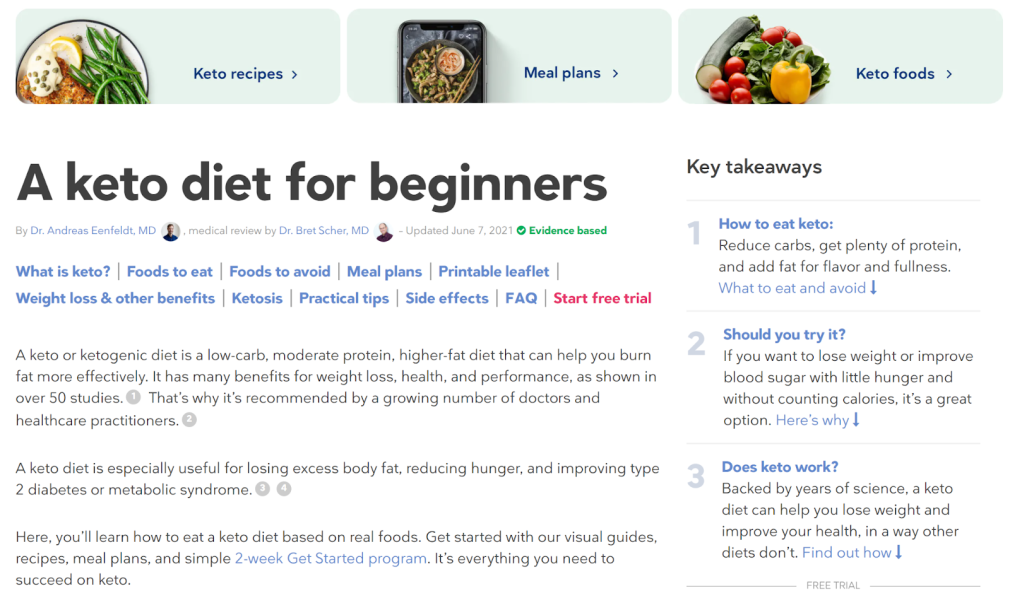 DietDoctor’s “Keto For Beginners” guide.
DietDoctor’s “Keto For Beginners” guide.Content Database
This format generally works best for directories or glossaries, where you have a large number of pages that cannot be practically listed in an article or on a traditional hub page. Usually, readers will be able to filter these articles to find what they want.
Some instances of when this format would be suitable include:
If you run a blog and have published a large number of reviews on individual products. If you run a fitness website and have written hundreds of articles each detailing how to perform a particular exercise. If you run an interior design website and want to showcase a large number of your previous projects.Audubon’s “Guide to North American Birds” hub page is an excellent example of a content database hub format, with each supporting piece of content linking off to articles about the selected bird.
 Audubon’s “Guide to North American Birds” hub page.
Audubon’s “Guide to North American Birds” hub page.Topic Matrix
Topic matrices are not often used because they can be a little overwhelming visually, but in instances where content pieces need to be categorized very specifically, it’s a good option.
Medical sites such as the NHS website and the Mayo Clinic often employ this kind of hub format, as it is well suited to informational types of content. It aligns closely with how you set up your website and URL structure, and prioritizes clear navigation and access to information over being aesthetically creative.
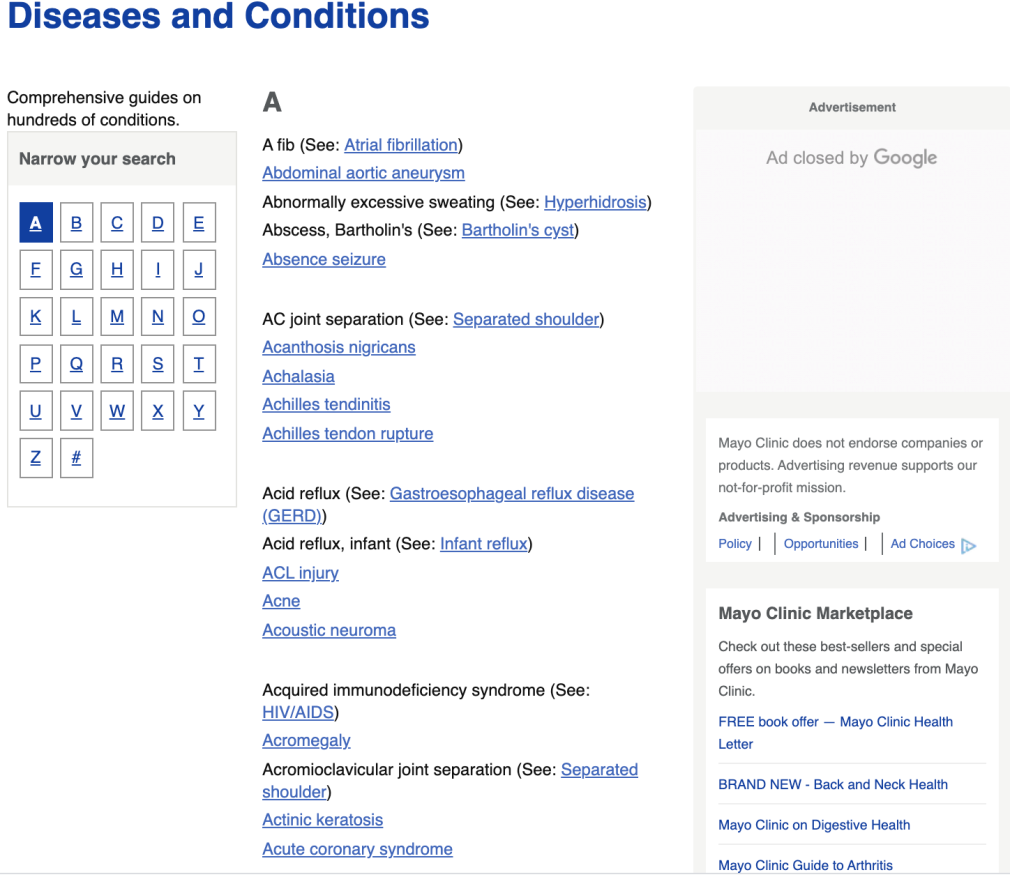 The Mayo Clinic’s ‘Diseases and Conditions’ hub page.
The Mayo Clinic’s ‘Diseases and Conditions’ hub page.Conclusion
Content hubs are a hugely effective way to structure your website’s content, both from an SEO and a performance perspective. If your content is well organized, appropriately connected, and able to provide authoritative solutions to a wide range of search queries, then it massively increases the chances of your content strategy being successful and your content marketing goals being met.
As we have seen throughout the article, the Semrush Content Marketing platform offers a number of dedicated tools that can assist you in this process, so be sure to check out the toolkit in full to see how it can help you create your own content hubs.
Innovative SEO services
SEO is a patience game; no secret there. We`ll work with you to develop a Search strategy focused on producing increased traffic rankings in as early as 3-months.
A proven Allinclusive. SEO services for measuring, executing, and optimizing for Search Engine success. We say what we do and do what we say.
Our company as Semrush Agency Partner has designed a search engine optimization service that is both ethical and result-driven. We use the latest tools, strategies, and trends to help you move up in the search engines for the right keywords to get noticed by the right audience.
Today, you can schedule a Discovery call with us about your company needs.
Source:





